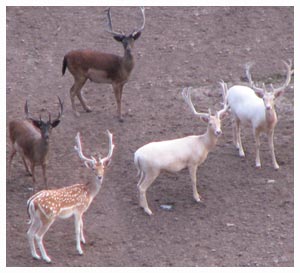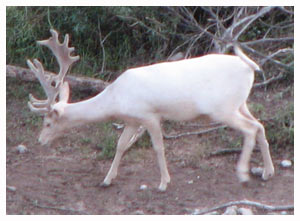Hunting Tips, Questions, Stories & Discussion
Focusing on managing Texas wildlife habitat and natural resources for native and exotic wild game species, for this and future generation of hunters and outdoor enthusiasts.Thursday, August 6, 2009
Hunting Report - August 1, 2009
 There are 6 fallow bucks below the house at the feeder tonight, and these sika bucks and elk between Betty’s and gravity. There was a hog chasing blackbuck does this am at tree, Betty was pissed, wanted me to drop everything and go kill the hog, but Lawrence is not on the ranch so I would have to clean it, not what I like to do before breakfast! It has been overcast and cool every day with sporadic rain, the high yesterday was 85, today 90! I have been working on roads and opening a new calachie pit between buck and intersection, we are trying to calachie the roads from the main road to buck, party, windmill, Betty’s.
There are 6 fallow bucks below the house at the feeder tonight, and these sika bucks and elk between Betty’s and gravity. There was a hog chasing blackbuck does this am at tree, Betty was pissed, wanted me to drop everything and go kill the hog, but Lawrence is not on the ranch so I would have to clean it, not what I like to do before breakfast! It has been overcast and cool every day with sporadic rain, the high yesterday was 85, today 90! I have been working on roads and opening a new calachie pit between buck and intersection, we are trying to calachie the roads from the main road to buck, party, windmill, Betty’s.Labels: fallow deer, sika buck hunting, trophy black buck antelope, wild boar hunting
Thursday, December 11, 2008
Fallow Deer: Is there a standard color for this species?
 For many hunters a Fallow deer seems like a bit of a strange species. Most hunters are used to hunting deer and being able to tell immediately what it is because there is only one possible coloration and pattern on the coat. The Fallow deer, however, actually has four separate and distinct color variations. Each is unique in its own way, but they are all the same type and species of deer. There are typically only three color variations seen in Texas and they are described below:
For many hunters a Fallow deer seems like a bit of a strange species. Most hunters are used to hunting deer and being able to tell immediately what it is because there is only one possible coloration and pattern on the coat. The Fallow deer, however, actually has four separate and distinct color variations. Each is unique in its own way, but they are all the same type and species of deer. There are typically only three color variations seen in Texas and they are described below:Melanistic – this is the darkest of the colors. It is an almost pure black coat coloration, sometimes black to very, very deep brown, with a white rump patch. Often this very dark coated Fallow deer is mistaken for a Sika deer at first glance.
White – likely the most commonly seen color variation, white coated Fallow deer are not albinos, they are a true white. The coat can range from a creamy color through to a champagne and white color. Unlike a true albino the eyes and skin are the normal color, not pink like you may expect.
Menil – this color variation includes a darker fawn color with white spots in the summer and a brownish gray coloration during the winter months. The heavier winter coat may retain some of the brown color or may be almost completely gray.
The fourth color variation is lighter than the menil with the spots almost never present during the winter months.
Labels: deer hunting, exotic deer, fallow deer, texas hunting ranch
Archives
December 2008 January 2009 February 2009 April 2009 May 2009 June 2009 July 2009 August 2009 September 2009 November 2009 December 2009 January 2010 February 2010 March 2010 April 2010
Subscribe to Posts [Atom]
